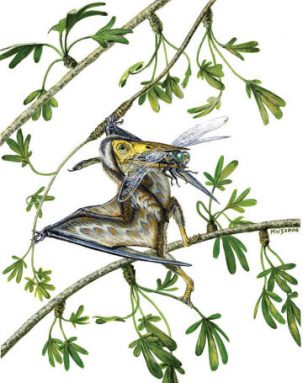Tiny pterodactyl
Scientists working in China have found the remains of the smallest pterodactyl ever known.
By Emily Sohn
Imagine a creature that’s a cross between a dinosaur and a bird and you’ll have a good idea of what a pterodactyl looked like. These ancient creatures were reptiles, but they flew. In fact, they were probably the first vertebrates to fly.
Pterodactyls could be huge. Some had wingspans that measured up to 10 meters (33 feet). But now, researchers working in northeastern China have found evidence of an extremely small pterodactyl. The animal’s wingspan measured just 25 centimeters (10 inches). The creature was about the size of a house sparrow.
 |
|
This illustration shows what a flying reptile called Nemicolopterus crypticus might have looked like. The sparrow-sized creature lived 120 million years ago in the forests of northeastern China. |
| M. Skrepnick |
The tiny pterodactyl has been named Nemicolopterus crypticus, which means “hidden flying forest dweller.” The animal had no teeth. And it lived 120 million years ago, say the scientists who found the fossil. They work at the National Museum of the Federal University of Rio de Janeiro, in Brazil.
The scientists found the fossil buried in rocks. Other fossils found in these same rocks indicate that the region used to be at the bottom of a lake in a heavily forested area.
Many of the bones in the animal’s feet were strongly curved. That suggests that N. crypticus spent a lot of time grasping tree limbs, says lead researcher Alexander W.A. Kellner.
On the basis of the size of its skull bones, the researchers could tell that the animal was not fully grown. They don’t know how much bigger it might have become.
But, Kellner says, “even if it were doubled in size, it would still be the smallest pterosaur yet found.”
Going Deeper:
Perkins, Sid. 2008. From China, the tiniest pterodactyl. Science News 173(Feb. 23):125-126. Available at http://www.sciencenews.org/articles/20080223/note13.asp .
Sohn, Emily. 2004. Dino bite leaves a tooth. Science News for Kids (July 14). Available at http://www.sciencenewsforkids.org/articles/20040714/Note2.asp .







